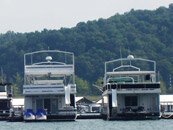Fenders
Fenders are cushions that prevent a boat from being damaged by rubbing/impacting a dock (when the boat’s tied up) or from being hurt by contact with another boat (when multiple boats are tied/rafted together).
There are a couple of basic types of boat fenders: inflatable and non-inflatable.
Inflatable fenders consist of an air bladder (bag) surrounded by a soft vinyl shell, and are available in a variety of cylindrical or spherical shapes, sizes, and colors. Using a small air pump (a bicycle tire pump, for example) with a needle attachment on the end of the hose (like you’d use to inflate a football), you can make an inflatable fender as hard or as soft as necessary by simply increasing or decreasing the air pressure in the fender.
Non-inflatable fenders are usually constructed of closed-cell foam or molded plastic, and unlike their inflatable counterparts, are available in odd shapes and sizes for applications where a cylindrical or spherical cushion just won’t work, such as on the squared corners of a pontoon boat or the sides of a low-slung bass boat.
Bumpers
Bumpers are also pads/cushions that prevent your boat from sustaining injury while it’s tied to the dock. What’s the difference between bumpers and fenders? Fenders are on the boat, while bumpers are on the dock. Same job, different approach.
Exactly where the bumpers are located really depends on the kind of dock, how the dock is used and what styles of boats typically use the dock. For instance, a pleasureboat dock constructed with the pilings (vertical support posts) underneath it, or a floating dock without pilings, could use a cushioned edging around its perimeter.
On the other hand, if the pilings are exposed, then you’d probably need to put padded bumpers on the pilings, as well as some protective edging on the sides of the dock.
Bumpers can range from something as simple as old tires hanging off the sides of the dock (very nautical looking, but the waterfront homeowners’ association might complain) to high-tech, specialty molded composite components as cool as the boat that they protect.

